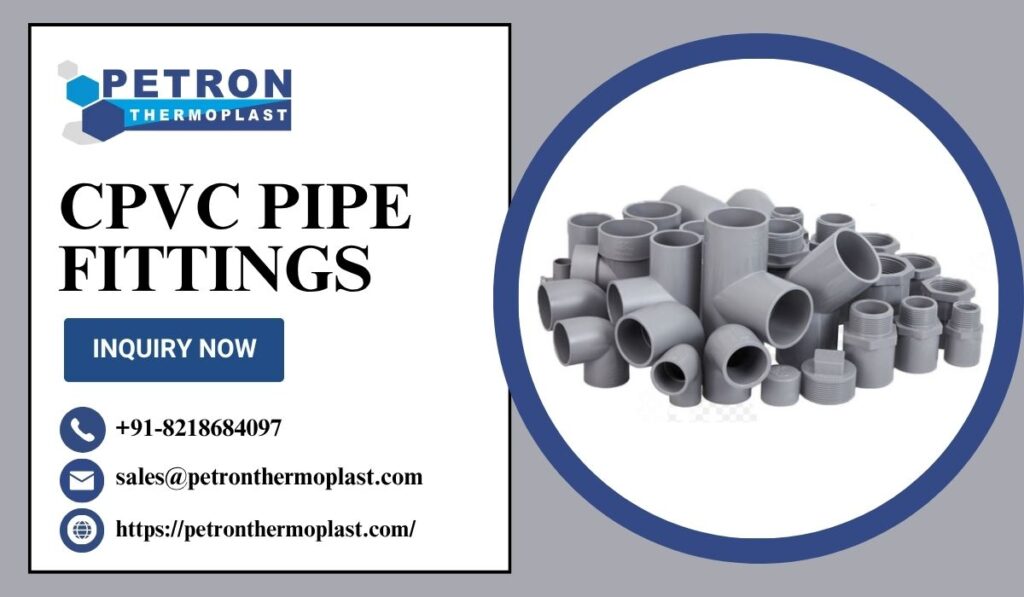When it comes to industrial or residential piping systems, CPVC pipe fittings are among the most reliable choices due to their strength, thermal resistance, and chemical durability. But with various sizes, designs, and standards available, choosing the right CPVC pipe fittings for your project can be overwhelming.
In this blog, we’ll walk you through all the essential factors to consider when selecting the best CPVC pipe fittings for your application. Whether you’re setting up a water supply system, industrial pipeline, or chemical processing unit, this guide will help ensure efficiency, safety, and long-term performance.
What Are CPVC Pipe Fittings?
Chlorinated Polyvinyl Chloride (CPVC) pipe fittings are used to connect different sections of CPVC pipes, redirect flow, or adjust the diameter of pipe systems. Known for their resistance to heat and corrosion, CPVC fittings are commonly used in:
- Hot and cold water plumbing
- Industrial chemical handling
- Fire sprinkler systems
- Water treatment plants
They come in various forms such as elbows, tees, reducers, couplings, valves, and flanges, each designed for specific flow control needs.
Key Advantages of CPVC Pipe Fittings
Before diving into selection criteria, here’s why CPVC pipe fittings are preferred:
- High Temperature Resistance: Withstand up to 93°C, suitable for hot water systems.
- Chemical Resistance: Compatible with acids, bases, and salts, ideal for chemical industries.
- Corrosion-Free: Unlike metal pipes, CPVC fittings do not rust or scale.
- Low Thermal Conductivity: Maintain fluid temperature efficiently.
- Easy Installation: Lightweight and compatible with solvent welding methods.
Factors to Consider When Choosing CPVC Pipe Fittings
- Understand Your Application
The first step is to determine the purpose of your piping system. Are you installing a plumbing system in a building, a chemical processing line, or a fire safety system?
Industrial Use: For aggressive chemicals, choose fittings rated for chemical compatibility and high pressure.
Residential Plumbing: Ensure fittings are certified for potable water use and have appropriate pressure ratings.
Fire Sprinklers: Look for UL-listed and FM-approved CPVC fittings specifically designed for fire safety applications.
- Check Size and Dimensions
CPVC pipe fittings come in various sizes (ranging from ½ inch to over 4 inches), and selecting the correct size is vital for flow efficiency and safety.
- Ensure compatibility with your CPVC pipes (standard dimensions follow ASTM D2846 or ASTM F441).
- Use a flow rate calculator if necessary to determine the correct diameter for your application.
- Consider reducers or adaptors if integrating with different piping systems.
- Choose the Right Fitting Type
Different projects require different types of CPVC fittings:
| Fitting Type | Function |
| Elbow (90°/45°) | Changes direction |
| Tee | Connects three pipes |
| Reducer | Joins different pipe sizes |
| Coupler | Connects two straight pipes |
| Union | Detachable connection |
| Flange | Flat connection to valves or pumps |
| Valves | Controls flow (ball valve, check valve, etc.) |
- Evaluate Pressure Rating
Check the pressure class of the fitting, typically marked in PN (Pressure Nominal) or PSI.
- PN 10 or PN 16 is suitable for standard water supply systems.
- Higher pressure ratings are required for industrial and chemical processing applications.
- Material Quality and Certification
Ensure that the CPVC fittings you choose are:
- Manufactured from virgin CPVC resin
- Certified for potable water (NSF/ANSI 61)
- Compliant with international standards like ASTM D1784 (CPVC Compound Type IV, Grade 1)
- Installation Method Compatibility
CPVC pipe fittings are generally installed using solvent cement welding, which creates a leak-proof bond between the pipe and fitting.
Ensure:
- The fittings are smooth and burr-free.
- You use the recommended CPVC solvent cement and primer.
- The fittings are compatible with manual or automated installation tools if required.
- Environmental and Fluid Compatibility
Check the compatibility of your fluid media with CPVC. Although CPVC is resistant to many chemicals, some strong solvents or highly concentrated acids may require alternative materials like PVDF or PP.
Also, consider:
- Ambient temperature conditions
- UV exposure (choose UV-stabilized fittings if installed outdoors)
- Vibration or thermal expansion in industrial plants
- Supplier Reputation and Support
Choose a trusted CPVC pipe fittings manufacturer or supplier like Petron Thermoplast, which offers:
- A full range of fittings and accessories
- Material test certificates and compliance documentation
- Custom sizes and bulk order support
- Fast delivery and after-sales assistance
CPVC Pipe Fittings Offered by Petron Thermoplast
At Petron Thermoplast, we supply a complete range of premium-grade CPVC pipe fittings, including:
- CPVC Elbow (90° & 45°)
- CPVC Equal Tee & Reducer Tee
- CPVC Coupler and Union
- CPVC Flanges (Blind, Spigot, Stub End)
- CPVC Valves (Ball, Check, Gate, Butterfly)
- CPVC Tank Connectors and Adaptors
Conclusion
Selecting the right CPVC pipe fittings is critical for the success and longevity of your piping system. By evaluating your project requirements, fluid compatibility, pressure and temperature conditions, and installation methods, you can ensure optimal performance. Whether you’re managing a residential project or an industrial system, Petron Thermoplast is your trusted partner for CPVC pipe fittings. Contact us today to get expert advice or request a quote for your project.


